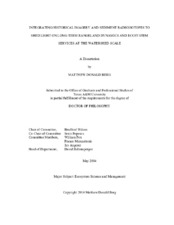| dc.description.abstract | Rangelands are widespread and include grasslands, shrublands, and woodlands,
covering more than two thirds of the earth’s land surface. This cover type represents half
of the land area in the United States. These systems are extremely dynamic and respond
to natural processes as well as varying degrees of human impact. In the southern Great
Plains, land cover and land use have changed dramatically over the last century.
However, there is tremendous uncertainty as to the timing and magnitude of such
transitions and much more so regarding the effects on hydrology and sediment dynamics
in these areas. Using a watershed approach in the Lampasas Cut Plain of Texas, we
applied object-oriented classification methods and hand-digitizing of historical aerial
photos to track the extent of woody plant cover, cropland area, and small ponds through
time. We compared these results with population trends to determine the relationship
between social and environmental variables. Finally, we conducted sediment analyses of
cores from constructed reservoirs in each watershed to establish a chronological
sequence of rangeland processes.
Woody plant cover displayed very complex responses between areas yet was
very similar among watersheds in the same setting. Prolonged decreases occurred over
the first half of the study period before rebounding in Lampasas County. By contrast,
shrub cover decreased and remained low and stable in Mills County over the last several
decades. Woody cover in an urbanized watershed consistently increased. Cropland area
showed marked decreases over all areas, declining by 77% between the 1930s and 2012.
The number of small ponds increased by over 250% over the same period. Trends in
woody plant cover were closely related to population in each context. The opposing
trends of cropland and pond density were strongly correlated. Precipitation, streamflow,
and baseflow were largely unchanged over the last 90 years, suggesting a minimal
impact of land use and land cover on local hydrology. Sediment delivery did increase
immediately after drought periods, when intense rainfall caused soil loss as a result of
drought-induced vegetation loss. These findings are critical to understanding the
implications for future sustainability of rangeland landscapes and the ecosystem services
they provide. | en |


